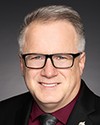I'm talking about the Métis. There you go. So I'm going to talk about the Métis. Mr. Serré is proud, and I'm a proud Métis. Yes, I'm a Métis.
My roots go back to the Red River colony on my grandfather's side. They continued to explore and trade in beaver pelts. French coureurs de bois not only populated Manitoba, Saskatchewan, Alberta, but also went to British Columbia. Fort Langley was the first capital of British Columbia. French coureurs de bois were there. French Canadians were just across the river from where I live. From the outset, French Canadians were in the west and all the other provinces. That's part of our identity as a people. I agree with this point in the motion. I don't agree with everything in the motion, but I agree with that point. Let's also think about Louis Riel and the ties between Quebec and the people of the Red River.
It's important to point out that we fought for the right to speak French and to be educated in French. That's something we always do in committee. In this committee, all the political parties, the NDP, the Bloc, the Liberals and the Conservatives, we're all here in committee because we want to protect French and advance the rights of francophones and francophiles. We also want to see them develop and progress in French.
We had the opportunity to hold several meetings here in committee where we conducted studies on trade. We want to see people doing business in French. We want them to learn French in school. We really want to. This is important, because we all know that French is an island in an anglophone sea. It's really important to preserve the language. We don't want to lose that jewel. The French language and French culture are a real jewel. That's what really differentiates us from the United States. I think that Quebec is a jewel. It's important to recognize not only Quebec francophones, but francophones across Canada as well.
I talked about my personal story, I talked a little about my Métis side. My mother, who is now deceased, was a Beaudoin. Our lineage goes back to 1640, when the first Beaudoins arrived here. It was among the first families here, in the Quebec City region, on the other side. When I have more time, I'll do more genealogical research, because it's very interesting.
At the beginning of the last century, around 1910, like everyone else, the Beaudoins had very large families. But with most people working on the farm, land was starting to run out. Some people had to move elsewhere to make a living as farmers. So, a few members of my family moved near Amos and Val-d'Or. Families continued to grow. In fact, my grandmother, Alice Beaudoin, had 18 children. Eventually, her family decided to move near Kapuskasing.
Incidentally, I'm still discussing the Canadian identity as a Conservative and as someone for whom it's really important. I'm glad to see that in this motion.
So my grandmother and her family moved to the Kapuskasing area and stayed there for some time. My mother was born in Opasatika, although I'd point out that my grandmother's children weren't all born there. Then, around 1941, they decided to move with the entire family to the Rivière de la Paix region. I don't know if other committee members have had a chance to go there, but a lot of small communities were settled there during the 1930s and 1940s, villages like Falher, Girouxville, Joussard and many more. There are villages like that in the region and many other regions as well. You also have Gravelbourg, in Saskatchewan, for example. Anyway, there are a lot of communities like that everywhere.
This is important because families were large at the time. As a result, there was a francophone society across the entire country, one in which people spoke French. What happened is that, with the inventions—right, Mr. Samson?—families got smaller and smaller.

